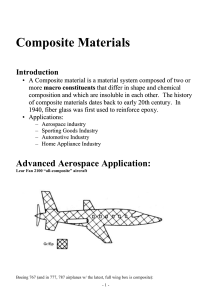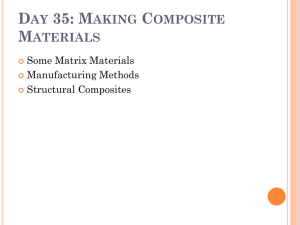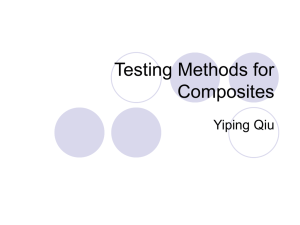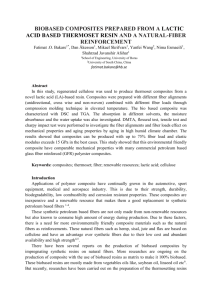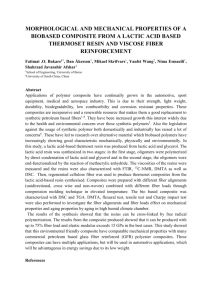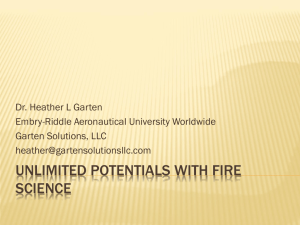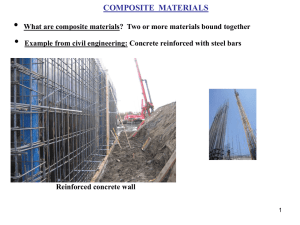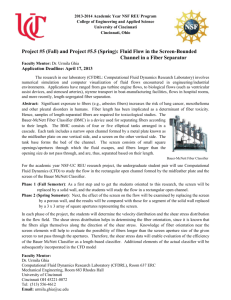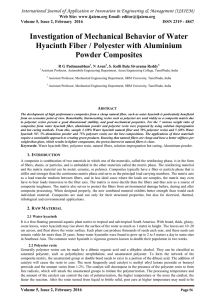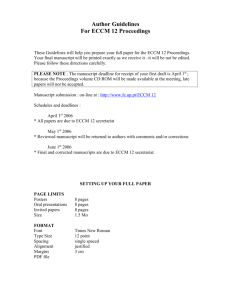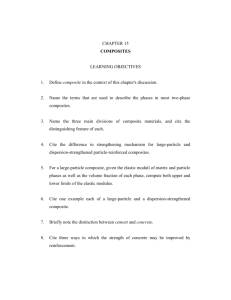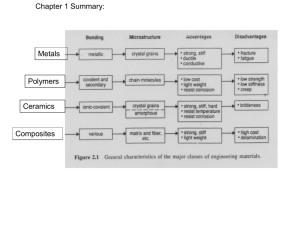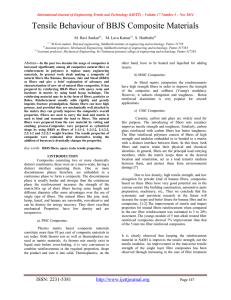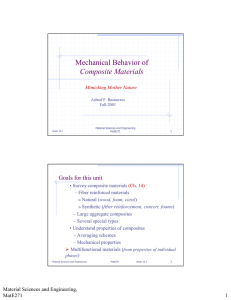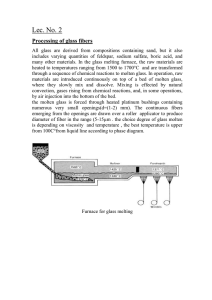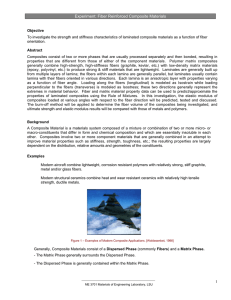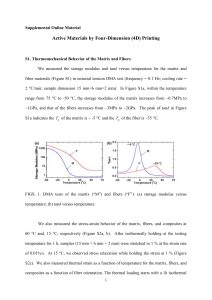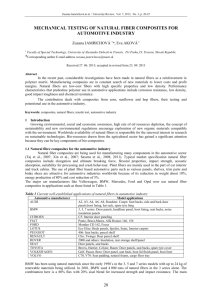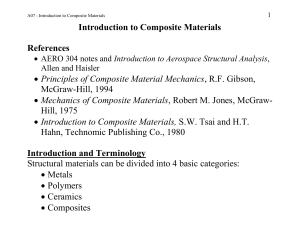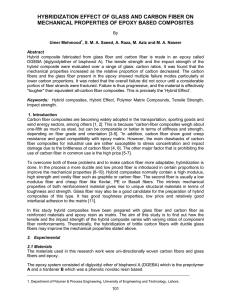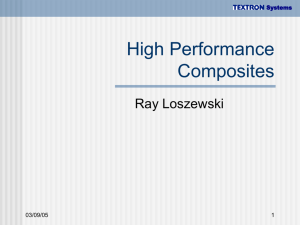File
advertisement
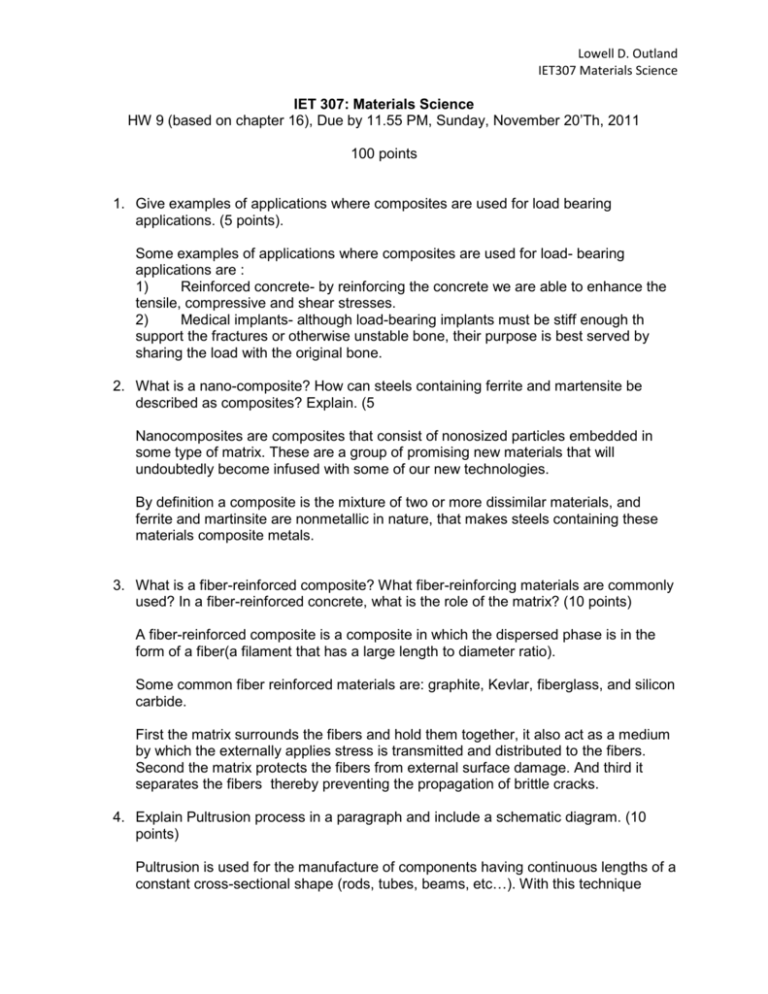
Lowell D. Outland IET307 Materials Science IET 307: Materials Science HW 9 (based on chapter 16), Due by 11.55 PM, Sunday, November 20’Th, 2011 100 points 1. Give examples of applications where composites are used for load bearing applications. (5 points). Some examples of applications where composites are used for load- bearing applications are : 1) Reinforced concrete- by reinforcing the concrete we are able to enhance the tensile, compressive and shear stresses. 2) Medical implants- although load-bearing implants must be stiff enough th support the fractures or otherwise unstable bone, their purpose is best served by sharing the load with the original bone. 2. What is a nano-composite? How can steels containing ferrite and martensite be described as composites? Explain. (5 Nanocomposites are composites that consist of nonosized particles embedded in some type of matrix. These are a group of promising new materials that will undoubtedly become infused with some of our new technologies. By definition a composite is the mixture of two or more dissimilar materials, and ferrite and martinsite are nonmetallic in nature, that makes steels containing these materials composite metals. 3. What is a fiber-reinforced composite? What fiber-reinforcing materials are commonly used? In a fiber-reinforced concrete, what is the role of the matrix? (10 points) A fiber-reinforced composite is a composite in which the dispersed phase is in the form of a fiber(a filament that has a large length to diameter ratio). Some common fiber reinforced materials are: graphite, Kevlar, fiberglass, and silicon carbide. First the matrix surrounds the fibers and hold them together, it also act as a medium by which the externally applies stress is transmitted and distributed to the fibers. Second the matrix protects the fibers from external surface damage. And third it separates the fibers thereby preventing the propagation of brittle cracks. 4. Explain Pultrusion process in a paragraph and include a schematic diagram. (10 points) Pultrusion is used for the manufacture of components having continuous lengths of a constant cross-sectional shape (rods, tubes, beams, etc…). With this technique Lowell D. Outland IET307 Materials Science continuous fiber rovings are first impregnated with a thermosetting resin. These are then pulled through a steel die that performs to the desired shape, and also establishes a resin fiber ratio. The stock then passes through a curing die that is precision machined so as to impart the final shape. This die is heated to initiate curing of the resin matrix. A pulling device pulls the stock through the dies and also determines production speed. Image retrieved from www.flickr.com 5. Calculate (a) the modulus of elasticity, (b) the tensile strength, and (c) the fraction of the load carried by the fiber for the following composite material stressed under Isostrain conditions. The composite consists of a continuous glass-fiber-reinforcedepoxy resin produced by using 60% by volume of E-glass fibers having a modulus of elasticity of Ef = 10.5*106 psi, a tensile strength of 350, 000 psi and a hardened epoxy resin with a modulus of Em = 0.45*106 psi and a tensile strength of 9000 psi. (Hint – See example problem 12.2 in your text book and associated equations before the problem) (20 points) a) Modulus of elasticity = 𝐸𝑐𝑙 = 𝐸𝑚 𝑉𝑚 + 𝐸𝑓 𝑉𝑓 = (.45*106)(0.4) + (10.5 ∗ 106 )(0.6) = 180,000 + 6,300,000 = 6,480,000 or 6.48*106 psi ′ b) Tensile strength = 𝜎𝑐𝑙∗ = 𝜎𝑚 (1 − 𝑉𝑓 ) + 𝜎𝑓∗ 𝑉𝑓 = 9000(1-0.6) +350,000(0.6) = 3600 +210,000 = 213,600 psi 𝐸 𝑉 c) Fraction of load carried by fiber = 𝐸 𝑓 𝑉𝑓 𝑚 𝑚 Lowell D. Outland IET307 Materials Science = (10.5∗106 )(0.6) (0.45∗106 )(0.4) 6,300,000 = 180,000 =35% of the load is carried by the fiber. 6. What are hybrid composites? Give examples. Why is it better than single fiber type? (10 points) Hybrid composites are composites that are fiber reinforced by two or more types of fibers such as glass and carbon in a single matrix. Hybrids have a better combination of properties than that of a single fiber type. Some examples include: Herculite XRV™ (Sybron Dental Specialties Inc/Kerr Dental, Orange, CA), Spectrum® TPH® (DENTSPLY Caulk, Milford, DE), and Charisma® (Heraeus Kulzer Inc). These hybrids are better because the offer the best properties from both fiber types, and are often stronger and more stiff. 7. What is a honeycomb core sandwich panel? What are its advantages and how is it made? (10 points) A honeycomb core sandwich panel is where thin foils have been formed into interlocking hexagonal cells with axes oriented perpendicular to the face panels. Strength and stiffness are dependent on cell size and cell wall thickness. These panels are normally lightweight compared to standard sandwich panels. 8. What are Aramid fibers? What types of chemical bonding takes place within the Aramid fibers? What types of chemical bonding takes place between the Aramid fibers? How does the bonding affect their mechanical strength properties? (10 points) Aramid fibers are high strength, high modulus materials that were introduced in the 1970’s. They are especially desirable for their outstanding strength to weight ratios, which are superior to those of metals. The type of bonding that takes place is a chemical bonding. High temperatures produce a significant number of chemical bonds between the matrix epoxy groups and the amide groups on the aramid fiber surface which produces a substantial increase in fiber-matrix adhesion. (Drzal) Mechanically these fibers have longitudinal tensile strengths and tensile moduli that are higher than other polymeric fiber materials. They are relatively week in compression. In addition the material is known for its toughness, impact resistance and resistance to creep. 9. What is Portland cement? How is it made? What advantages and disadvantages does concrete offer as a composite material? (10 points) Lowell D. Outland IET307 Materials Science Portland cement is a finely ground mixture of clay and lime-bearing minerals that has been heated to about 1400c in a rotary kiln. The resulting product is then ground into a very fine powder to which a small amount of gypsum is added to retard the setting process. One disadvantage is that all the ingredients must be add in the proper proportions, for example too little water leads to incomplete bonding, while too much water will result in excessive porosity. 10. Original tennis rackets were made of natural wood. Nowadays, composite materials such as carbon-fiber-reinforced-epoxy are the material of choice for tennis rackets. Explain what properties are important in the design of a tennis racket frame. What are the advantages of the current materials used in the frame of the tennis racket? (10 points) Some of the properties that are important in the manufacturing of tennis rackets are: 1) light weight , 2) strength, 3) must not be brittle, 4) must be resistant to deformation. Advantages in using current materials for tennis racket frames include: 1) current materials are less likely to warp or become deformed, 2) these materials are lighter in weight than original materials, 3) they are also more impact resistant. Works Cited Drzal, S. I. (n.d.). Retrieved 11 17, 2011, from www.iccm-central.org.
